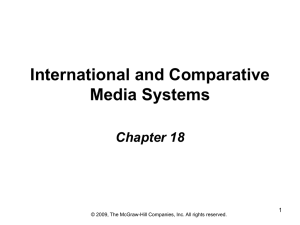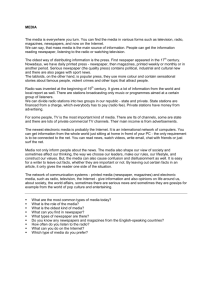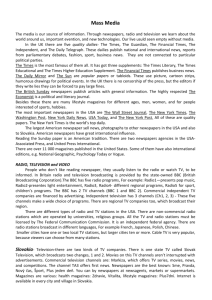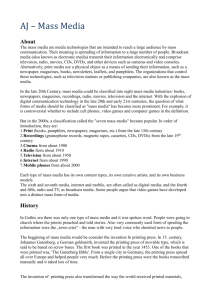Introduction to Media Management: Mass Media & Journalism
advertisement
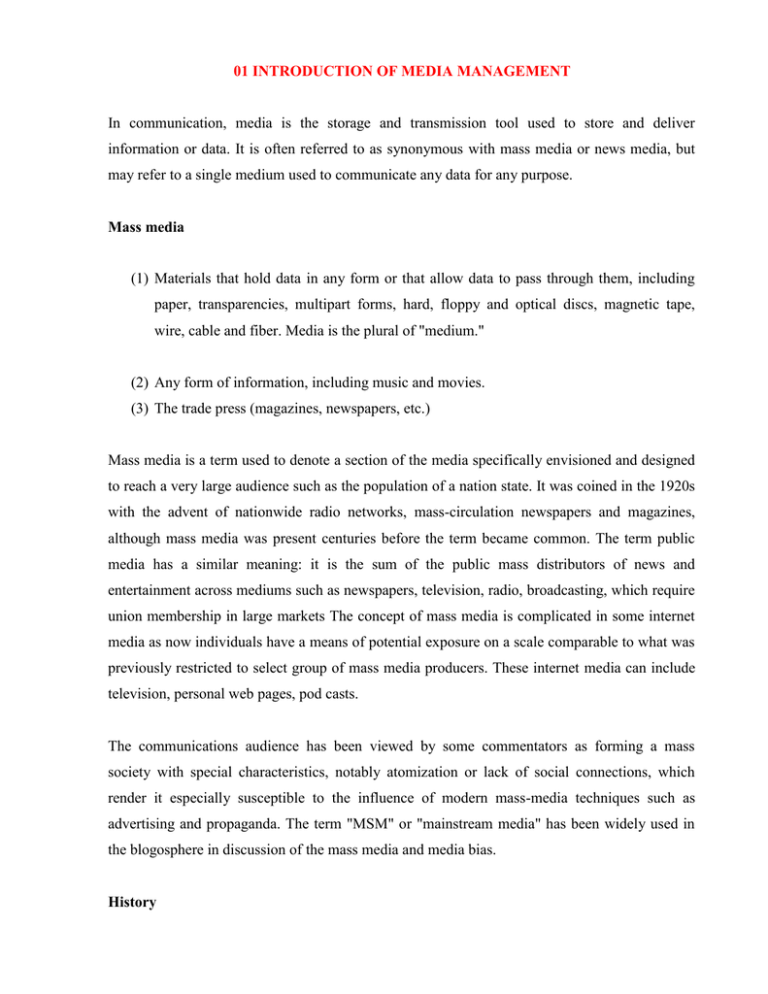
01 INTRODUCTION OF MEDIA MANAGEMENT In communication, media is the storage and transmission tool used to store and deliver information or data. It is often referred to as synonymous with mass media or news media, but may refer to a single medium used to communicate any data for any purpose. Mass media (1) Materials that hold data in any form or that allow data to pass through them, including paper, transparencies, multipart forms, hard, floppy and optical discs, magnetic tape, wire, cable and fiber. Media is the plural of "medium." (2) Any form of information, including music and movies. (3) The trade press (magazines, newspapers, etc.) Mass media is a term used to denote a section of the media specifically envisioned and designed to reach a very large audience such as the population of a nation state. It was coined in the 1920s with the advent of nationwide radio networks, mass-circulation newspapers and magazines, although mass media was present centuries before the term became common. The term public media has a similar meaning: it is the sum of the public mass distributors of news and entertainment across mediums such as newspapers, television, radio, broadcasting, which require union membership in large markets The concept of mass media is complicated in some internet media as now individuals have a means of potential exposure on a scale comparable to what was previously restricted to select group of mass media producers. These internet media can include television, personal web pages, pod casts. The communications audience has been viewed by some commentators as forming a mass society with special characteristics, notably atomization or lack of social connections, which render it especially susceptible to the influence of modern mass-media techniques such as advertising and propaganda. The term "MSM" or "mainstream media" has been widely used in the blogosphere in discussion of the mass media and media bias. History Newspapers developed around from 1612, with the first example in English in 1620 but they took until the nineteenth century to reach a mass-audience directly. The first dated printed book known is the "Diamond Sutra", printed in China in 868 AD, although it is clear that books were printed earlier. Movable clay type was invented in 1041 in China. However, due to the slow spread of literacy to the masses in China, and the relatively high cost of paper there, the earliest printed mass-medium was probably European popular prints from about 1400.Types of drama in numerous cultures were probably the first mass-media, going back into the Ancient World. During the 20th century, the growth of mass media was driven by technology that allowed the massive duplication of material. Physical duplication technologies such as printing, record pressing and film duplication allowed the duplication of books, newspapers and movies at low prices to huge audiences. Radio and television allowed the electronic duplication of information for the first time. • Mass media had the economics of linear replication: a single work could make money proportional to the number of copies sold, and as volumes went up, unit’s costs went down, increasing profit margins further. Vast fortunes were to be made in mass media. In a democratic society, independent media serve to educate the public/electorate about issues regarding government and corporate entities. Journalism In journalism, a story refers to a single article, news item or feature. A story is usually relevant to a single event, issue, theme, or profile of a person. Stories are usually inspired through news pegs (the central premise of the story). Journalism is a discipline of collecting, analyzing, verifying, and presenting Information regarding current events, trends, issues and people. Those who practice journalism are known as journalists. Public relations A public relations (PR) is the practice of managing the flow of information between an organization and its publics. Public is the art and science of managing communication between an organization and its key publics to build, manage and sustain its positive image. Examples include: • Corporations use marketing public relations (MPR) to convey information about the products they manufacture or services they provide to potential customers to support their direct sales efforts. Typically, they support sales in the short and long term, establishing and burnishing the corporation's branding for a strong, ongoing market. Forms Electronic media and print media include: • Broadcasting, in the narrow sense, for radio and television. • Various types of discs or tape. In the 20th century, these were mainly used for music. Video and computer uses followed. • Film, most often used for entertainment, but also for documentaries. • Internet, which has many uses and presents both opportunities and challenges. Blogs and pod casts, such as news, music, pre-recorded speech and video) • Publishing, in the narrow sense, meaning on paper, mainly via books, magazines, and newspapers. Audio recording and reproduction Sound recording and reproduction is the electrical or mechanical re-creation and/or amplification of sound, often as music. This involves the use of audio equipment such as microphones, recording devices and loudspeakers. Broadcasting Television and radio programs are distributed through radio broadcasting over frequency bands that are highly regulated by the Federal Communications Commission. Such regulation includes determination of the width of the bands, range, licensing, types of receivers and transmitters used, and acceptable content. Cable programs are often broadcast simultaneously with radio and television programs, but have a more limited audience. By coding signals and having decoding equipment in homes, cable also enables subscription-based channels and pay-per-view services. Broadcasting is the distribution of audio and/or video signals (programs) to a number of recipients ("listeners" or "viewers") that belong to a large group. This group may be the public in general, or a relatively large audience within the public. Film Film is a term that encompasses motion pictures as individual projects, as well as the field in general. The origin of the name comes from the fact that photographic film (also called film stock) has historically been the primary medium for recording and displaying motion pictures. Many other terms exist — motion pictures (or just pictures or "picture"), the silver screen, photoplays, the cinema, picture shows, flicks — and commonly movies. Internet Toward the end of the 20th century, the advent of the World Wide Web marked the first era in which any individual could have a means of exposure on a scale comparable to that of mass media. For the first time, anyone with a web site can address a global audience, although serving to high levels of web traffic is still relatively expensive. The Internet (also known simply as "the Net" or "the Web") can be briefly understood as "a network of networks". Specifically, it is the worldwide, publicly accessible network of interconnected computer networks that transmit data by packet switching using the standard Internet Protocol (IP). It consists of millions of smaller domestic, academic, business, and governmental networks, Which together carry various information and services, such as electronic mail, online chat, file transfer, and the interlinked Web pages and other documents of the World Wide Web? Contrary to some common usage, the Internet and the World Wide Web are not synonymous: the Internet is a collection of interconnected computer networks, linked by copper wires, fiber-optic cables, wireless connections etc.; the Web is a collection of interconnected documents, linked by hyperlinks and URLs. The World Wide Web is accessible via the Internet, along with many other services including e-mail, file sharing and others described below. The internet is quickly becoming the center of mass media. Everything is becoming accessible via the internet. Instead of picking up a newspaper, or watching the 10 o'clock news, people will log onto the internet to get the news they want, when they want it. Many workers listen to the radio through the internet while sitting at their desk. Games are played through the internet. Blogging has become a huge form of media, popular through the internet. Even the education system relies on the internet. Teachers can contact the entire class by sending one e-mail. They have web pages where students can get another copy of the class outline or assignments. Some classes even have class blogs where students must post weekly, and are graded on their contributions. The internet thus far has become an extremely dominant form of media. Publishing Publication is also important as a legal concept; (1) as the process of giving formal notice to the world of a significant intention, for example, to marry or enter bankruptcy, and; (2) as the essential precondition of being able to claim defamation; that is, the alleged libel must have been published. Publishing is the industry concerned with the production of literature or information – the activity of making information available for public view. In some cases, authors may be their own publishers. Traditionally, the term refers to the distribution of printed works such as books and newspapers. With the advent of digital information systems and the Internet, the scope of publishing has expanded to include websites, blogs, and the like. As a business, publishing includes the development, marketing, production, and distribution of newspapers, magazines, books, literary works, musical works, software and other works dealing with information. Book In library and information science, a book is called a monograph to distinguish it from serial publications such as magazines, journals or newspapers. A book is a collection of sheets of paper, parchment or other material with a piece of text written on them, bound together along one edge within covers. A book is also a literary work or a main division of such a work. A book produced in electronic format is known as an e-book. Magazine Magazines can be classified as: • General interest magazines (e.g. Frontline, India Today, The Week, etc.) • Special interest magazines (women's, sports, business, scuba diving, etc.) A magazine is a periodical publication containing a variety of articles, generally financed by advertising and/or purchase by readers. Newspaper The first printed newspaper was published in 1605, and the form has thrived even in the face of competition from technologies such as radio and television. A newspaper is a publication containing news and information and advertising, usually printed on low-cost paper called newsprint. Software publishing Developers may use publishers to reach larger or foreign markets, or to avoid focusing on marketing. Or publishers may use developers to create software to meet a market need that the publisher has identified. A software publisher is a publishing company in the software industry between the developer and the distributor. In some companies, two or all three of these roles may be combined (and indeed, may reside in a single person, especially in the case of shareware). Software publishers often license software from developers with specific limitations, such as a time limit or geographical region. The terms of licensing vary enormously, and are typically secret. Management can also refer to the person or people who perform the act of management. Theoretical scope Management functionally, as the action of measuring a quantity on a regular basis and of adjusting some initial plan; or as the actions taken to reach one's intended goal. This applies even in situations where planning does not take place. From this perspective, Frenchman Henri Fayol considers management to consist of five functions: 1. Planning 2. Organizing 3. Leading 4. Co-coordinating 5. Controlling Some people, however, find this definition, while useful, far too narrow. The phrase "management is what managers do" occurs widely, suggesting the difficulty of defining management, the shifting nature of definitions, and the connection of managerial practices with the existence of a managerial cadre or class. Speakers of English may also use the term "management" or "the management" as a collective word describing the managers of an organization, for example of a corporation. Historically this use of the term was often contrasted with the term "Labor" referring to those being managed. Nature of managerial work Public, private, and voluntary sectors place different demands on managers, but all must retain the faith of those who select them (if they wish to retain their jobs), retain the faith of those people that fund the organization, and retain the faith of those who work for the organization. If they fail to convince employees of the advantages of staying rather than leaving, they may tip the organization into a downward spiral of hiring, training, firing, and recruiting. Management also has the task of innovating and of improving the functioning of organizations. In for-profit work, management has as its primary function the satisfaction of a range of stakeholders. This typically involves making a profit (for the shareholders), creating valued products at a reasonable cost (for customers), and providing rewarding employment opportunities (for employees). In nonprofit management, add the importance of keeping the faith of donors. In most models of management/governance, shareholders vote for the board of directors, and the board then hires senior management. Some organizations have experimented with other methods (such as employee-voting models) of selecting or reviewing managers; but this occurs only very rarely. Historical development Classical economists such as Adam Smith (1723 - 1790) and John Stuart Mill (1806 - 1873) provided a theoretical background to resource-allocation, production, and pricing issues. About the same time, innovators like Eli Whitney (1765 - 1825), James Watt (1736 - 1819), and Matthew Bolton (1728 - 1809) developed elements of technical production such as standardization, quality-control procedures, cost-accounting, interchangeability of parts, and work-planning. Many of these aspects of management existed in the pre- 1861 slave- based sector of the US economy. That environment saw 4 million people, as the contemporary usages had it, "managed" in profitable quasi-mass production. By the late 19th century, marginal economists Alfred Marshall (1842 - 1924) and Leon Walras (1834 - 1910) and others introduced a new layer of complexity to the theoretical underpinnings of management. Joseph Wharton offered the first tertiary-level course in management in 1881. The first comprehensive theories of management appeared around 1920. The Harvard Business School invented the Master of Business Administration degree (MBA) in 1921. People like Henri Fayol (1841 - 1925) and Alexander Church described the various branches of management and their inter-relationships. In the early 20th century, people like Ordway Tead (1891 - 1973), Walter Scott and J. Mooney applied the principles of psychology to management, while other writers, such as Elton Mayo (1880 - 1949), Mary Parker Follett (1868 - 1933), Chester Barnard (1886 - 1961), Max Weber (1864 - 1920), Rensis Likert (1903 - 1981), and Chris Argyris (1923 - ) approached the phenomenon of management from a sociological perspective. In the 1940s, Patrick Blackett combined these statistical theories with microeconomic theory and gave birth to the science of operations research. Operations research, sometimes known as "management science" (but distinct from Taylor's scientific management), attempts to take a scientific approach to solving management problems, particularly in the areas of logistics and operations. Some of the more recent developments include the Theory of Constraints, management by objectives, reengineering, and various information-technology-driven theories such as agile software development, as well as group management theories such as Cog's Ladder. Towards the end of the 20th century, business management came to consist of six separate branches, namely: • Human resource management • Operations management or production management • Strategic management • Marketing management • Financial management • Information technology management responsible for management information systems In the 21st century observers find it increasingly difficult to subdivide management into functional categories in this way. More and more processes simultaneously involve several categories. Instead, one tends to think in terms of the various processes, tasks, and objects subject to management. Branches of management theory also exist relating to non-profits and to government: such as public administration, public management, and educational management. Further, management programs related to civil-society organizations have also spawned programs in nonprofit management and social entrepreneurship. Functions: Management operates through various functions, often classified as planning, organizing, leading/motivating and controlling. • Planning: deciding what needs to happen in the future (today, next week, next month, next year, over the next five years, etc.) and generating plans for action. • Organizing: making optimum use of the resources required to enable the successful carrying out of plans. • Leading/Motivating: exhibiting skills in these areas for getting others to play an effective part in achieving plans. • Controlling: monitoring -- checking progress against plans, which may need modification based on feedback. The four functions of management are: The base function is to: Plan It is the foundation area of management. It is the base upon which the all the areas of management should be built. Planning requires administration to assess; where the company is presently set, and where it would be in the upcoming. From there an appropriate course of action is determined and implemented to attain the company’s goals and objectives Planning is unending course of action. There may be sudden strategies where companies have to face. Sometimes they are uncontrollable. You can say that they are external factors that constantly affect a company both optimistically and pessimistically. Depending on the conditions, a company may have to alter its course of action in accomplishing certain goals. This kind of preparation, arrangement is known as strategic planning. In strategic planning, management analyzes inside and outside factors that may affect the company and so objectives and goals. Here they should have a study of strengths andWeaknesses, opportunities and threats. For management to do this efficiently, it has to be very practical and ample. The subsequent function is to: Organize The second function of the management is getting prepared, getting organized. Management must organize all its resources well before in hand to put into practice the course of action to decide that has been planned in the base function. Through this process, management will now determine the inside directorial configuration; establish and maintain relationships, and also assign required resources. While determining the inside directorial configuration, management ought to look at the different divisions or departments. They also see to the harmonization of staff, and try to find out the best way to handle the important tasks and expenditure of information within the company. Management determines the division of work according to its need. It also has to decide for suitable departments to hand over authority and responsibilities. The third function is to: Direct Directing is the third function of the management. Working under this function helps the management to control and supervise the actions of the staff. This helps them to assist the staff in achieving the company’s goals and also accomplishing their personal or career goals which can be powered by motivation, communication, department dynamics, and department leadership. Employees those which are highly provoked generally surpass in their job performance and also play important role in achieving the company’s goal. And here lies the reason why managers focus on motivating their employees. They come about with prize and incentive programs based on job performance and geared in the direction of the employees requirements. A communication plan includes: • Target audiences • Key messages • A budget A calendar for message releaseplanning for communication is the art and science of reaching target audiences using marketing communication channels such as advertising, public relations, experiences or direct mail for example. It is concerned with deciding who to target, when, with what message and how. Business policy: • The mission of the business is its most obvious purpose -- which may be, for example, to make soap. • The objective of the business refers to the ends or activity at which a certain task is aimed. • The business's policy is a guide that stipulates rules, regulations and objectives, and may be used in the managers' decision-making. It must be flexible and easily interpreted and understood by all employees. • The business's strategy refers to the plan of action that it is going to take, as well as the resources that it will be using, to achieve its mission and objectives. It is a guideline to managers, stipulating how they ought to use best the factors of production to the business's advantage. Initially, it could help the managers decide on what type of business they want to form. How to implement policies and strategies • All policies and strategies must be discussed with all managerial personnel and staff. • Managers must understand where and how they can implement their policies and strategies. • A plan of action must be devised for each department. • Policies and strategies must be reviewed regularly. • Contingency plans must be devised in case the environment changes. • Assessments of progress ought to be carried out regularly by top-level managers. • A good environment is required within the business. The development of policies and strategies • The missions, objectives, strengths and weaknesses of each department must be analyzed to determine their roles in achieving the business's mission. • The forecasting method develops a reliable picture of the business's future environment. • A planning unit must be created to ensure that all plans are consistent and that policies and strategies are aimed at achieving the same mission and objectives. • Contingency plans must be developed, just in case. All policies must be discussed with all managerial personnel and staff that are required in the execution of any departmental policy. • They give mid- and lower-level managers a good idea of the future plans for each department. • A framework is created whereby plans and decisions are made. • Mid- and lower-level management may add their own plans to the business's strategic ones. Communications management is the systematic planning, implementing, monitoring, and revision of all the channels of communication within an organization, and between organizations; it also includes the organization and dissemination of new communication directives connected with an organization, network, or communications technology. Aspects of communications management include developing corporate communication strategies, designing internal and external communications directives, and managing the flow of information, including online communication. New technology forces constant innovation on the part of communications managers. Roles of communications managers • Design of organizational communications structures • Define communications principles and standards • Formulate the communications goals of the organization • Manage and monitor information flows • Organize crisis communications • Implement communications strategies • Research the communications context • Resonance analysis of team networks • Organize communications training for staff • Provide corporate presentations to publics, media and cybernetic space • Communication can be defined as "the transfer of meanings between persons and groups". The purpose of communication may range from completing a task or mission to creating and maintaining satisfying human relationships. The word transfer means more than the simple process of "packaging" an idea as conceived by a sender and transporting it to the mind of a receiver, where it is "unpackaged". It implies the creation of meaning in the mind of a sender followed by a re-creation of the same meaning in the mind of a receiver. If something occurs along the way to change the sender's original meaning, the communication has failed in its intent. • • Communication may be considered a functional part of an organizational system, and it may be considered in an interpersonal context. • • The structure of an organization is determined in part by the network of channels or paths along which information must flow between members or subunits. • • Effective Media Management • • EMM is an independent media management consultancy, set up ten years ago to advise clients on the media issues which matter most to international advertisers, and to evaluate, benchmark and monitor those advertisers' media investments. • • As media becomes more complex, so too does it need to become more accountable. Advertisers are increasingly recognizing the need for independent support, advice and scrutiny of the type provided by EMM. • Historically, media auditing was the only independent tool used to address these needs, but smarter clients are now turning to more wide-ranging media management programmes as their preferred solution. • EMM delivers effective media management programmes tailor-made for marketing directors, finance and procurement professionals within large domestic and multinational advertisers.
